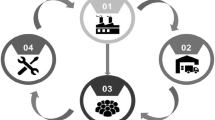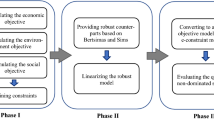Abstract
This paper addresses a multi-period capacitated closed-loop supply chain (CLSC) network design problem subject to uncertainties in the demands and returns as well as the potential carbon emission regulations. Two promising regulatory policy settings are considered: namely, (a) a carbon cap and trade system, or (b) a tax on the amount of carbon emissions. A traditional CLSC network design model using stochastic programming is extended to integrate robust optimization to account for regulations of the carbon emissions caused by transportation. We propose a hybrid model to account for both regulatory policies and derive tractable robust counterparts under box and ellipsoidal uncertainty sets. Implications for network configuration, product allocation and transportation configuration are obtained via a detailed case study. We also present computational results that illustrate how the problem formulation under an ellipsoidal uncertainty set allows the decision maker to balance the trade-off between robustness and performance. The proposed method yields solutions that provide protection against the worst-case scenario without being too conservative.






Similar content being viewed by others
References
Akçalı E, Çetinkaya S, Üster H (2009) Network design for reverse and closed-loop supply chains: an annotated bibliography of models and solution approaches. Networks 53(3):231–248
Atamtürk A., Zhang M (2007) Two-stage robust network flow and design under demand uncertainty. Oper Res 55(4):662–673
Atasu A, Guide Jr V, Wassenhove L (2008) Product reuse economics in closed-loop supply chain research. Prod Oper Manag 17(5):483–496
Atasu A, Van Wassenhove L, Sarvary M (2009) Efficient take-back legislation. Prod Oper Manag 18(3):243–258
Baron O, Milner J, Naseraldin H (2011) Facility location: a robust optimization approach. Prod Oper Manag 20(5):772–785
Ben-Tal A, El Ghaoui L, Nemirovski A (2009) Robust optimization. Princeton University Press, Princeton
Ben-Tal A, Nemirovski A (1999) Robust solutions of uncertain linear programs. Oper Res Lett 25(1):1–14
Ben-Tal A, Nemirovski A (2000) Robust solutions of linear programming problems contaminated with uncertain data. Math Program 88(3):411–424
Benjaafar S, Li Y, Daskin M (2013) Carbon footprint and the management of supply chains: insights from simple models. IEEE Trans Autom Sci Eng 10(1):99–116
Benz E, Truck S (2009) Modeling the price dynamics of CO2 emission allowances. Energy Econ 31(1):4–15
Bertsimas D, Brown D, Caramanis C (2011) Theory and applications of robust optimization. SIAM Rev 53:464
Bertsimas D, Sim M (2003) Robust discrete optimization and network flows. Math Program 98(1–3):49–71
Bertsimas D, Sim M (2004) The price of robustness. Oper Res 52(1):35–53
Bertsimas D, Thiele A (2006) A robust optimization approach to inventory theory. Oper Res 54(1):150–168
Birge J, Louveaux F (1997) Introduction to stochastic programming. Springer, New York
Bohringer C, Rutherford T, Tol R (2009) The EU 20/20/2020 targets: an overview of the EMF22 assessment. Energy Econ 31:S268–S273
Borgatti SP, Everett MG (2006) A graph-theoretic perspective on centrality. Soc Netw 28(4):466–484
Byrne J, Waegel A, Haney B, Tobin D, Alleng G, Karki J, Suarez J (2006) Pathways to a us hydrogen economy: vehicle fleet diffusion scenarios. Technical report, Newark, DE: Center for Energy and Environmental Policy
Chaabane A, Ramudhin A, Paquet M (2012) Design of sustainable supply chains under the emission trading scheme. IInt J Prod Econ 135(1):37–49
Chaabane A, Ramudhin A, Paquet M, Benkaddour M (2008) An integrated logistics model for environmental conscious supply chain network design. In: Proceedings of AMCIS 2008, pp 175–187
Chouinard M, DAmours S, Aït-Kadi D (2008) A stochastic programming approach for designing supply loops. Int J Prod Econ 113(2):657–677
Dekker R, Bloemhof J, Mallidis I (2012) Operations research for green logistics—an overview of aspects, issues, contributions and challenges. Eur J Oper Res 219(3):671–679
Diabat A, Abdallah T, Al-Refaie A, Svetinovic D, Govindan K (2013) Strategic closed-loop facility location problem with carbon market trading. Eng Manag IEEE Trans 60(2):398–408
Diabat A, Simchi-Levi D (2009) A carbon-capped supply chain network problem. In: Proceedings of 2009 IEEE international conference on industrial engineering and engineering management (IEEE), pp 523–527
Dufour J, Hallin M (1993) Improved eaton bounds for linear combinations of bounded random variables, with statistical applications. J Am Stat Assoc 88(423):1026–1033
Easwaran G, Üster H (2010) A closed-loop supply chain network design problem with integrated forward and reverse channel decisions. IIE Trans 42(11):779–792
EIA (2009) Emissions of greenhouse gases report. Technical report. http://www.eia.gov/oiaf/1605/ggrpt/carbon.htmlemissions
El Ghaoui L, Lebret H (1997) Robust solutions to least-squares problems with uncertain data. SIAM J Matrix Anal Appl 18:1035–1064
Eskandarpour M, Dejax P, Péton O, Bostel N (2012) A state of the art of supply chain design models and methods integrating the principles of sustainable development. In: ROADEF 2012
Fahimnia B, Sarkis J, Dehghanian F, Banihashemi N, Rahman S (2013) The impact of carbon pricing on a closed-loop supply chain: an Australian case study. J Clean Prod 59:210–225
Ferris MC, Jain R, Dirkse S (2011) Gdxmrw: Interfacing gams and matlab. Technical report, Computer Sciences Department, University of Wisconsin–Madison. http://www.gams.com/dd/docs/tools/gdxmrw.pdf.
Flachsland C, Brunner S, Edenhofer O, Creutzig F (2011) Climate policies for road transport revisited (ii): closing the policy gap with cap-and-trade. Energy Policy 39:2100–2110
Gui L, Atasu A, Ergun O, Toktay B (2010) Fair cost allocation mechanisms in electronic waste collection and recycling networks. In: Proceedings of the behavioral and quantitative game theory: conference on future directions
Guide VDR, Van Wassenhove L (2009) The evolution of closed-loop supply chain research. Oper Res 57(1):10–18
Higle J (2005) Stochastic programming: optimization when uncertainty matters. Tutorials in operations research, pp 30–53
Hoen K, Tan T, Fransoo J, Van Houtum G (2014) Effect of carbon emission regulations on transport mode selection under stochastic demand. Flex Serv Manuf J 26:170–195
Hua G, Cheng T, Wang S (2011) Managing carbon footprints in inventory control. Int J Prod Econ 132(2):178–186
Jiang N, Sharp B, Sheng M (2009) New Zealand’s emissions trading scheme. N Z Econ Pap 43(1):69–79
Krikke H (2011) Impact of closed-loop network configurations on carbon footprints: a case study in copiers. Resour Conserv Recycl 55(12):1196–1205
Lee S, Pollitt H, Ueta K (2012) An assessment of Japanese carbon tax reform using the E3MG econometric model. Sci World J 2012. doi:10.1100/2012/835917
Listes O (2007) A generic stochastic model for supply-and-return network design. Comput Oper Res 34(2):417–442
Melo M, Nickel S, Saldanha-Da-Gama F (2009) Facility location and supply chain management—a review. Eur J Oper Res 196(2):401–412
Meng S, Siriwardana M, McNeill J (2013) The environmental and economic impact of the carbon tax in Australia. Environ Resour Econ 54:313–332
Miller BL, Wagner HM (1965) Chance constrained programming with joint constraints. Oper Res 13:930–945
Mudchanatongsuk S, Ordónez F, Liu J (2007) Robust solutions for network design under transportation cost and demand uncertainty. J Oper Res Soc 59(5):652–662
Mulvey J, Vanderbei R, Zenios S (1995) Robust optimization of large-scale systems. Oper Res 43(2):264–281
Pirog R, Van Pelt T, Enshayan K, Cook E (2001) Food, fuel, and freeways. Technical report, Leopold Center for Sustainable Agriculture, Iowa State University, Ames
Pishvaee M, Rabbani M, Torabi S (2011) A robust optimization approach to closed-loop supply chain network design under uncertainty. Appl Math Model 35(2):637–649
Ramudhin A, Chaabane A, Kharoune M, Paquet M (2008) Carbon market sensitive green supply chain network design. In: Proceedings of 2008 IEEE international conference on industrial engineering and engineering management (IEEE), pp 1093–1097
Ryder (2012) Ryder recognized as an inbound logistics green supply chain partner. Ryder’s News Release. http://investors.ryder.com/newsroom/News-Release-Details/2012/Ryder-Recognized-as-an-Inbound-Logistics-Green-Supply-Chain-Partner1130515/default.aspx.
Santoso T, Ahmed S, Goetschalckx M, Shapiro A (2005) A stochastic programming approach for supply chain network design under uncertainty. Eur J Oper Res 167(1):96–115
Seuring S (2013) A review of modeling approaches for sustainable supply chain management. Decis Support Syst 54(4):1513–1520
Soyster A (1973) Convex programming with set-inclusive constraints and applications to inexact linear programming. Oper Res 21(5):1154–1157
Acknowledgments
This material is based upon work supported by the National Science Foundation under Grant No. 1130900.
Author information
Authors and Affiliations
Corresponding author
Rights and permissions
About this article
Cite this article
Gao, N., Ryan, S.M. Robust design of a closed-loop supply chain network for uncertain carbon regulations and random product flows. EURO J Transp Logist 3, 5–34 (2014). https://doi.org/10.1007/s13676-014-0043-7
Received:
Accepted:
Published:
Issue Date:
DOI: https://doi.org/10.1007/s13676-014-0043-7




